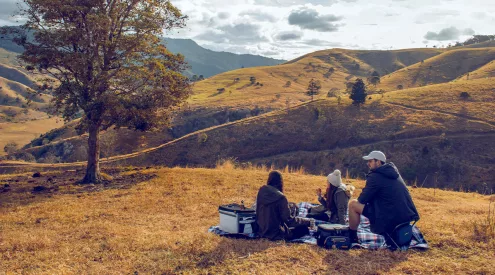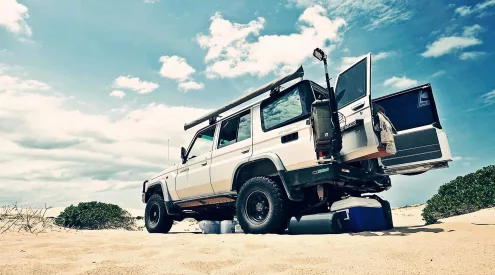Motorcyclists are at constant risk, operating their motorcycles for recreational rides and business commuting. The condition of our roads, and traffic congestion, pose a very dynamic threat to life on two wheels.
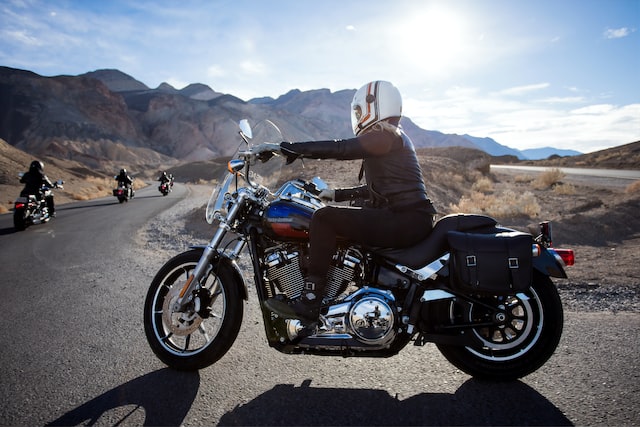
Picture: Unsplash
Trucks are even more so, especially when the roadworthiness of the truck, the competency of the driver and the goods being transported are not kept in check.
In the following questions, Hein will provide much-needed advice on how to deal with trucks and the various risk factors attached to these vehicles.
What are the major challenges for our motorcyclists navigating the road near trucks?
There are a few risk factors or elements that stand out above all else:
- Size
This must be your first red flag as the size of the truck can adversely affect the driver’s ability to see you, or to manoeuvre and control the truck. - Fluids
A poorly maintained truck can drop diesel or oil like a torrential downpour. It is important that you rely on your smell and sight senses before it is too late. Change in road surface colour is not a government initiative, it is usually the first sign of “stay the hell off that”. - Tyres
Again, poorly maintained trucks can pop a retreat tyre right in front of you or fling it sideways when it explodes off the rim. Don’t take a black object in the road for something else, decide on your actions around it as quickly and safely as you can.
Remember, hitting a piece of rubber will help you fly but it won’t help you with the landing! - Visibility
The next time you see a truck parked, go stand next to it and walk around it. You will quickly realise that this thing can seriously hamper visibility, it has several hiding spots for you and your bike.
Visibility is not spelt “Slip Stream”, yes, when you sit in the slipstream of a truck and trailer, your visible reserve is zero, nada!
Read more about The Visible Reserve here – https://www.msi.org.za/the-visible-reserve/ - Sound
The noise the truck creates can affect the noise you create with your bike. Some folks believe in the myth that “Loud pipes save lives”, but nothing really compares to the sound a truck can create in the cabin or outside. Not all trucks are Volvos, there are some old rust buckets out there ready to win a Grammy Award. Another red flag and a very good reason to steer clear and make your way past with pace and space. - Cargo
The weight and dimensions of the cargo add to the size of the truck package, adds to the drop in visibility, and certainly will add to the manoeuvrability of the truck. Don’t sit there on your bike and gawk at the huge CAT on the flatbed, or all the beautiful cars on the carrier. Rather go and stop somewhere safe and take your pictures as it drives past. The longer you stare at the cargo, the longer you are exposed to every risk this truck can throw at you. Unless you see your girlfriend in the cabin with the driver, move on! - Manoeuvrability
If you can smell brake pads burning, it is a clear sign that the truck is under braking strain, especially downhill. Exhaust or engine braking sounds nice but it can only do so much in slowing the truck down.
There are so many factors and elements that will affect the manoeuvrability of a truck, the skill and experience of the drive for one, then add weather, poor road conditions, truck maintenance, tyres, load, and brakes to the mix. Is this really something you can deal with when it goes South? Get away from this thing, and ensure you maintain a healthy safety buffer all around you. Don’t even think to get into a fight with a truck, and no brake testing!
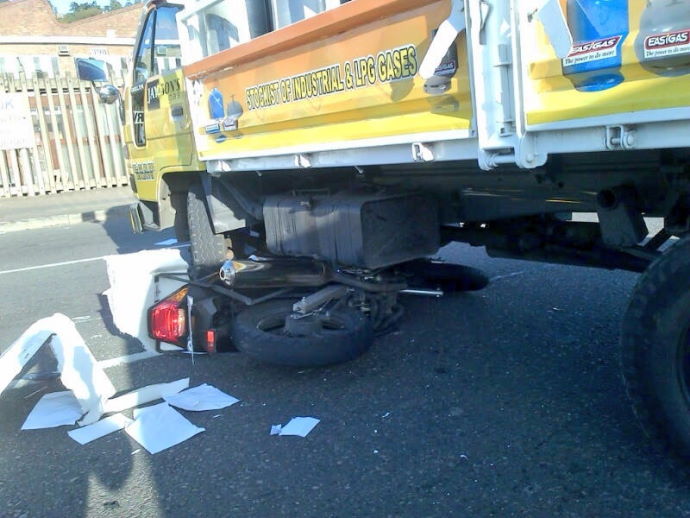
Who would be the “Most Vulnerable” of the riders?
The answer is simple here – The Fool: the ignorant and arrogant!
Sure, new riders put themselves at risk when they don’t realise how dangerous riding around trucks can be. I’ll put my money and time into them; you can still teach them something. A fool should be treated like a truck – steer clear with pace and space!
What are the major mistakes riders make when sharing roads with trucks?
Well, the first will be a lack of anticipation. You are not born with this ability; it must be learned.
The second mistake is ignorance. Not realising your risk around a dangerous object is detrimental to your health.
The third mistake is arrogance. If you are a “me, myself, and I” rider, you should take public transport.
Let me point out a few, just to be clear:
- Riding in the slipstream of the truck and trailer
- Following too close to the truck will affect the rider’s visibility and manoeuvrability
- Cutting in front of a truck at a Stop or at a junction, or when overtaking
- Riding too close to the side of the truck
- Taking your time when overtaking a truck
How important is awareness of blind spots and what would your advice be to riders?
The bigger the vehicle, the bigger the blind spots. A small profile vehicle (motorcycle) can easily be hidden, intentionally or unintentionally, in these blind spots. It is important to know where these blind spots are, the size of the blind spots, and how they can affect the visibility of the driver.
When you see a blind spot, go around it if you can, otherwise go through swiftly.
This illustration shows the blind spots a standard truck will have:
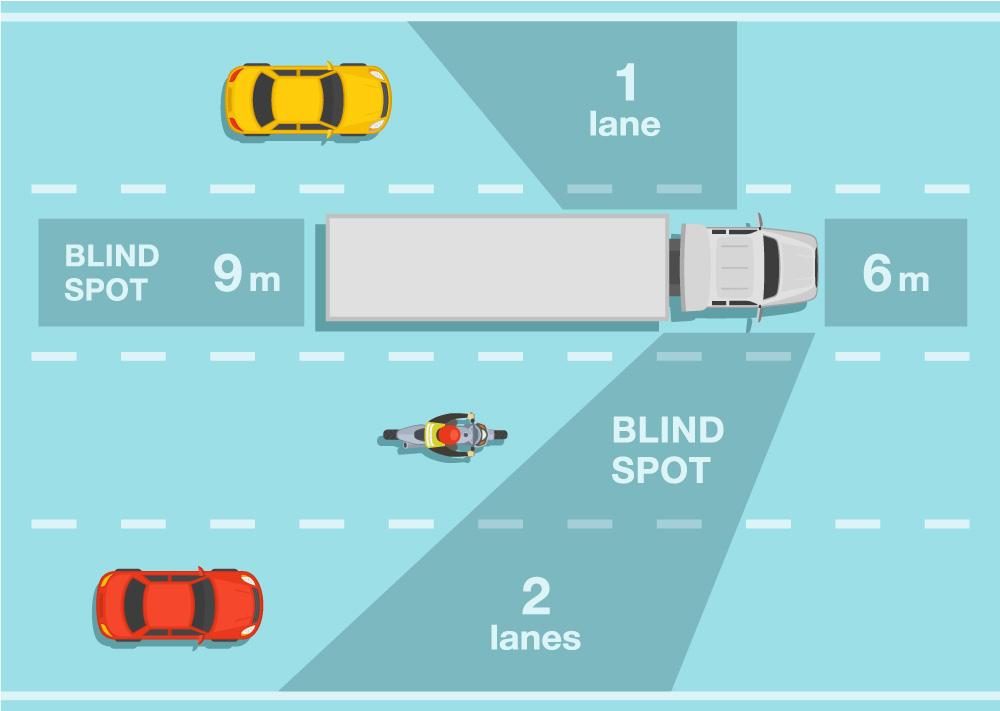
What are the unique challenges when sharing roads with trucks in bad weather?
The most important factor, that comes to mind, is anticipation. We don’t adapt our riding to changing weather or road conditions quickly enough. Some riders snap at the brakes or dodge an object last minute before waking up to the situation.
Riding among trucks in bad or wet weather affects everything: braking distance, manoeuvrability, and visibility. And don’t forget those beautiful rainbow colours floating to the surface.
Here one must give them a lot of space, increase their following distance, and not ride in the water spray caused by a truck.
What are the most common “Death Traps” left by trucks that motorcyclists must be aware of?
- Trucks offer a slipstream so you can go faster with less wind resistance.
- Trucks offer protection against side winds.
- Trucks offer warmth in the winter when you ride close to the exhaust.
Now, if you took me seriously on these points, you’re a fool!
Take special note of pieces of retreat tyres and rubber, and oil or more common diesel spills left in the wake of a truck. Take your smell and sight senses to another level when riding on busy truck routes.
What should the motorcyclist do when seeing the truck driver ahead driving recklessly?
I mentioned this before; take action well in advance, anticipate and decide on your escape path. Do not get into a fight with a reckless driver while on the road. If you want to get involved, stop, and notify the authorities like SANRAL on the N-routes, or if you see a po-po, stop and inform him/her of the matter.
How can rider training and group riding awareness contribute towards increased safety?
Although there is no motorcycle vs truck training that I know of, Advanced Rider Training will hone your skills and equip you to better handle situations around trucks. Proper training not only increases your confidence but also makes you a more effective road user – making yourself part of the solution and not the problem.
Read more on why training is important here – https://www.msi.org.za/why-get-trained/
Any additional advice our riders need to be aware of while sharing roads with trucks?
The first thing a rider must realise is that this thing is big and dangerous. It poses a significant risk to everyone around it – do not take anything for granted.
Learn from every road-sharing experience with trucks and adapt accordingly.
Source: Arrive Alive
Follow us on social media for more travel news, inspiration, and guides. You can also tag us to be featured.
TikTok | Instagram | Facebook | Twitter
ALSO READ: Kruger rhino poacher handed 34-year prison sentence










